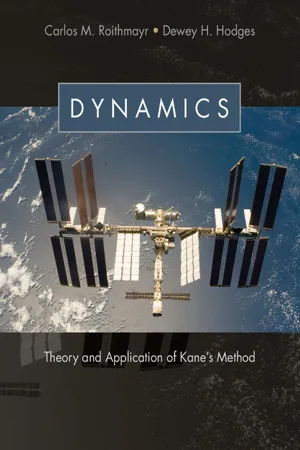
- English
- PDF
- Available on iOS & Android
About this book
This book is ideal for teaching students in engineering or physics the skills necessary to analyze motions of complex mechanical systems such as spacecraft, robotic manipulators, and articulated scientific instruments. Kane's method, which emerged recently, reduces the labor needed to derive equations of motion and leads to equations that are simpler and more readily solved by computer, in comparison to earlier, classical approaches. Moreover, the method is highly systematic and thus easy to teach. This book is a revision of Dynamics: Theory and Applications (1985), by T. R. Kane and D. A. Levinson, and presents the method for forming equations of motion by constructing generalized active forces and generalized inertia forces. Important additional topics include approaches for dealing with finite rotation, an updated treatment of constraint forces and constraint torques, an extension of Kane's method to deal with a broader class of nonholonomic constraint equations, and other recent advances.
Frequently asked questions
- Essential is ideal for learners and professionals who enjoy exploring a wide range of subjects. Access the Essential Library with 800,000+ trusted titles and best-sellers across business, personal growth, and the humanities. Includes unlimited reading time and Standard Read Aloud voice.
- Complete: Perfect for advanced learners and researchers needing full, unrestricted access. Unlock 1.4M+ books across hundreds of subjects, including academic and specialized titles. The Complete Plan also includes advanced features like Premium Read Aloud and Research Assistant.
Please note we cannot support devices running on iOS 13 and Android 7 or earlier. Learn more about using the app.
Information

Table of contents
- Cover
- Half Title
- Title
- Copyright
- Contents
- Preface
- Preface to Dynamics: Theory and Applications
- To the Reader
- 1 Differentiation of Vectors
- 2 Kinematics
- 3 Constraints
- 4 Mass Distribution
- 5 Generalized Forces
- 6 Constraint Forces, Constraint Torques
- 7 Energy Functions
- 8 Formulation of Equations of Motion
- 9 Extraction of Information from Equations of Motion
- 10 Kinematics of Orientation
- Problem Sets
- Appendix I Direction Cosines as Functions of Orientation Angles
- Appendix II Kinematical Differential Equations in Terms of Orientation Angles
- Appendix III Inertia Properties of Uniform Bodies
- Index